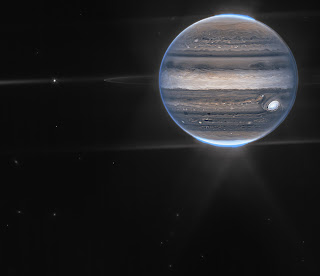Saturn's Rings: A Dance of Ice and Sunlight:
Saturn's mesmerizing rings are primarily composed of ice particles that brilliantly reflect the Sun's light. This phenomenon creates a celestial spectacle, enhancing the planet's ethereal charm. The James Webb Space Telescope, with its advanced capabilities, has immortalized this beauty in a breathtaking image, showcasing Saturn and its delicate ring system. However, it is crucial to note that Saturn's counterparts, Jupiter, Uranus, and Neptune, also possess their own unique rings, albeit with distinct characteristics.
Jupiter's Rings: A Subtle Elegance:
Unlike Saturn's dazzling rings, Jupiter's rings exude a more understated elegance. Composed of less dense and extensive dust particles, they reflect light poorly in the visible spectrum. To observe these rings effectively, one must position themselves behind Jupiter, with the planet's disk obstructing the Sun's light. This ingenious technique led to the serendipitous discovery of Jupiter's rings in 1979 during Voyager 1's momentous flyover. Since then, various space probes, including Galileo, and terrestrial observatories, notably the Hubble Space Telescope, have diligently studied these enigmatic rings, unraveling their mysteries.
The James Webb Telescope Unveils the Unseen:
The James Webb Space Telescope, an instrument of unparalleled capability, enables astronomers to explore the cosmos in the infrared spectrum. This unique vantage point provides a clearer view of dust emissions and, subsequently, a deeper understanding of planetary rings. Through the lens of the James Webb, we witness the enthralling beauty of Jupiter's rings, accompanied by stunning auroras that illuminate the planet's poles with an intense blue hue. Additionally, the telescope captures the presence of Amaltea and Adrastea, two captivating moons orbiting Jupiter, further enhancing the allure of this extraordinary celestial body.
Conclusion: A Symphony of Colors and Discoveries:
In conclusion, the discovery and observation of planetary rings have enriched our understanding of the vast wonders of the universe. Saturn's resplendent rings, composed of ice particles that radiate the Sun's light, have captured our collective imagination for centuries. Meanwhile, Jupiter's more subtle rings, adorned with dust particles, offer a captivating elegance of their own. Thanks to the groundbreaking capabilities of the James Webb Space Telescope, we can now witness the hidden beauty of these celestial phenomena, unraveling their mysteries in vivid detail. Let us marvel at the cosmic symphony of colors and discoveries, forever expanding our knowledge of the cosmos.
Image Credit: NASA, ESA, CSA


Post a Comment